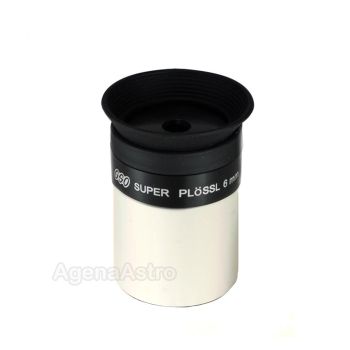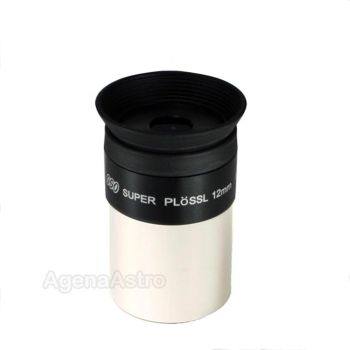GSO 1.25" Plossl Eyepiece - 4mm

Contiguous US Customers:
All items we sell ship for free within the Contiguous US. Shipping will be via the cheapest shipping method which will vary depending on the items in your order. During checkout, you may also be shown other optional faster shipping choices.
US Customers in Hawaii and Alaska:
Free shipping applies to almost all products. A few large telescopes and mounts are excluded from this free shipping offer. For these items, please contact us to obtain a shipping quote before you check out using the online shopping cart.
International Customers:
Free shipping does not apply to international orders. During check-out, you will be presented with several shipping choices and costs. However, the export of some items may be restricted outside the US due to size or manufacturer restrictions.
Quick Overview
- 1.25 inch 4mm plossl eyepiece, 52 degree apparent field of view
- Fully multi-coated lenses, 4 lens elements, Blackened lens edges
- 6mm eye relief, fold-down rubber eyeguard
- Threaded for standard 1.25" astronomy filters
- Weight 2.6oz., Made in Taiwan
Product Details
GSO's Super-Plossl eyepieces have been some of our most popular sellers over the years. Users will experience incredible views without breaking the bank or impinging on your telescope's balance. They represent what is perhaps the best buy today for astronomers on a budget or for beginners. But don't be fooled by their low prices - these might well turn out to be all the eyepieces you will ever need!
The GSO Super-Plossls are available in a 1.25" barrel size and 9 different focal lengths ranging from 4mm to 40mm. The 4mm, 6mm and 9mm models are great for high power planetary and lunar observation. The 12mm and 15mm are perfect intermediate focal lengths, performing well on both deep-sky and planetary subjects. The 20mm and 25mm models would be excellent choices for low power scanning of open star clusters and viewing larger galaxies. The 32mm and 40mm models offer a wide field and are superb for wide field scanning, detailed observations of large diffuse subjects or as a finder eyepiece.
Features:
- All eyepieces are fully multicoated (FMC) for maximum light transmission
- High quality lenses provide the best-possible sharpness all over the field of view
- Blackened lens edges reduce light scattering and improve contrast
- Fold-down rubber eyecups to keep out stray light
- Comfortable eye relief at all but the shortest focal lengths (As in all Plossl eyepieces, eye relief can get tight at the shorter focal lengths but this is design constraint, not a fault of these eyepieces)
- Includes two end caps.
Old below
Important note: Depending on your telescope, this eyepiece may provide magnifications that are too high! While it can be very useful for viewing the Sun, Moon, brighter planets and terrestrial objects, it is not for everyone or for common viewing conditions.
Before buying, please make sure that you are using realistic magnifications with your telescope. A good rule of thumb is that under very good conditions and with a very good telescope, the maximum power you will be able to use is about 50x of magnification per inch of telescope aperture. With average telescopes and/or average conditions, you might be limited to 30x of magnification per inch of telescope aperture. So for example, if you have a 5" telescope, under typical conditions you might typically use 5x30 = 150x of magnification, and 5x50 = 250x of magnification at best. If your telescope has a focal length of, say, 1200mm, then this eyepiece will result in a magnification of 1200 / 4 = 300x which is probably too much for this telescope.
Also, when you magnify an object, its light is spread over a larger area. Since the brightness of the object being viewed hasn't changed, this means that the image you see will be fainter. Double the magnification and the image will get 4 times fainter. This is a basic law of physics, but people often forget this and complain that the "image is not bright enough" when they increase the magnification to very high powers.
Boosting the magnification beyond the recommended maximum for your telescope aperture is not realistic. This is bound to result in image break-down, causing faint, fuzzy images, focusing difficulties, increased color around objects and general disappointment. Use the eyepiece in the right settings and with the correct expectations, and you will enjoy it.
Other Information
- Country of Manufacture: Taiwan
| Eyepiece Series | Super-Plossl |
|---|---|
| Focal Length | 4mm |
| Barrel Size | 1.25" (31.7mm) |
| Apparent Field of View (Mfg Specified) | 52° |
| Eye Relief (Designed) | 6mm |
| Filter Threads | Standard 1.25" Filter Thread (M28.5 x 0.6) |
| Coatings | Fully Multi-Coated |
| Lens Elements | 4 |
| Blackened Lens Edges | Yes |
| Barrel Type | Smooth sided |
| Protective Plastic Storage Container | Yes - Free Agena Eyepiece Container |
| Protective Plastic Storage Container Size | Agena 42x60mm |
| Optical Design | Plossl |
| Height (With Eyeguard Extended) | 52mm |
| End Caps | 2 |
| Rubber Eye Guard | Yes |
| Weight | 2.6 oz |















